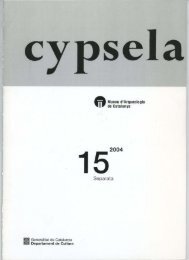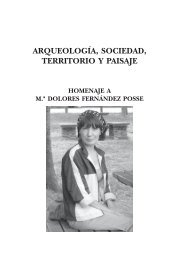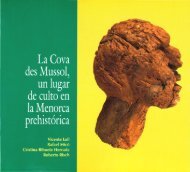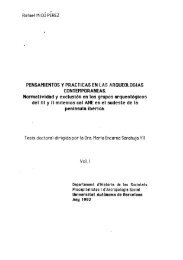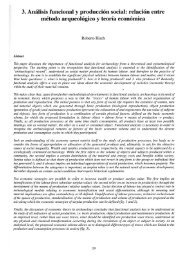Análisis Funcional - Arqueoecología Mediterránea - Universitat ...
Análisis Funcional - Arqueoecología Mediterránea - Universitat ...
Análisis Funcional - Arqueoecología Mediterránea - Universitat ...
Create successful ePaper yourself
Turn your PDF publications into a flip-book with our unique Google optimized e-Paper software.
4. <strong>Análisis</strong> funcional y producción en las sociedades cazadorasrecolectoras:<br />
significación de los cambios tecnológicos durante<br />
el mesolítico<br />
Abstract<br />
Ermengol Gassiot Ballbè<br />
During the last years the interest about the comprehension of the consumption dinamics in prehistoric societies has<br />
grown. This fact has affected the study of hunter-gatherer societies in different ways. On the one hand, the development<br />
of the functional analysis has provided an increasing empirical evidence about the modalities of use and amortization<br />
of the stone tools. On the other hand, from a liberal perspective, the self-denominated Evolutionary Ecology shows an<br />
special interest in defining the consumption in relation to the individual benefit optimization. In this work, however, an<br />
economical analysis of the Upper Palaeolithic and Mesolithic populations in the northern Iberian Peninsula is<br />
presented. From an economical materialist theory, we emphasize the necessity of understanding the consumption within<br />
the framework of the social life production. In this proposal the functional analysis provides empirical arguments which<br />
give theoric statements the substantive explanatory nature.<br />
The main argument here defended concerns to the economical signification of the factors consumption in production.<br />
This can happen under the form of use of means and instruments of work to realize a determinated activity and like<br />
consumption means of life by the force of labour. The distinction between objective consumption and subjective<br />
consumption is stablished on the basis of the comprehension of these processes like acts of social transmission of value<br />
and identifying who or what the receiver is. On understanding consumption like an act of production where social value<br />
is amortized and transferred, time becomes a very important variable. It indicates us the length of the utensils' live and<br />
of the time in which the effort implicated in their manufature is socially compensated. Moreover, it conditions the social<br />
production as a whole on stablishing the rhythm of the amortization of factorsí inversion on the food productive cycles<br />
and other goods. This fact demands that the diachronic dimension of the use of the means of prodution is considered in<br />
the analysis of prehistorical productions.<br />
In the last part of the article we present the heuristic potential of this proposal. The study of the technological changes<br />
occured between 14.000 calBC and 5.500 calBC under this prism must not be exclusively understood in relation to the<br />
individual yield of the different kind of artifacts. The way in which these are socially amortized directly falls into the<br />
general trend of the decreasing yields that governs hunter-gatherer economies. It allows a more complex view about the<br />
social production in this period as well as pointing out new explicative causes. We fundamentally justify that, to a<br />
certain extent, the characteristic changes during the Mesolithic in Western Europe can be understood from the same<br />
social production.<br />
El análisis funcional es una vía de aproximación a la<br />
tecnología de una época dada (Semenov 1981). Así<br />
mismo, la determinación de las cualidades técnicas de la<br />
actividad laboral que activa la producción aporta<br />
información no sólo de las características del trabajo<br />
humano en cada período sino también del conjunto de la<br />
organización económica. Para alcanzar este último<br />
objetivo es necesaria la articulación del análisis funcional<br />
como método arqueológico y del análisis económico<br />
como teoría cobertora. A éste último el análisis funcional<br />
aporta su necesaria dimensión empírica y lo traslada al<br />
plano de la realidad concreta. La teoría económica<br />
facilita, a su vez, la capacidad para trascender los<br />
contextos individuales de la observación empírica y<br />
relacionarlos con el conjunto de la actividad social en la<br />
31<br />
que se insertan. El análisis del trabajo como capacidad<br />
humana de transformar intencionalmente la materia para<br />
cubrir determinadas necesidades sociales constituye el<br />
argumento para llevar a cabo esta actividad.<br />
Sin embargo, de forma paralela a su popularización<br />
dentro de nuestra disciplina, en varios trabajos se ha<br />
entendido el método funcional fundamentalmente como<br />
una forma para caracterizar el uso particular de los<br />
diferentes objetos líticos que conforman el registro<br />
arqueológico (Grace 1989). Esta visión, restrictiva ya en<br />
el hecho de que excluye una amplia gama de restos<br />
arqueológicos (en cambio, tratados en varias ponencias<br />
de este volumen), limita también el tipo de información<br />
que potencialmente puede aportar el análisis funcional.




